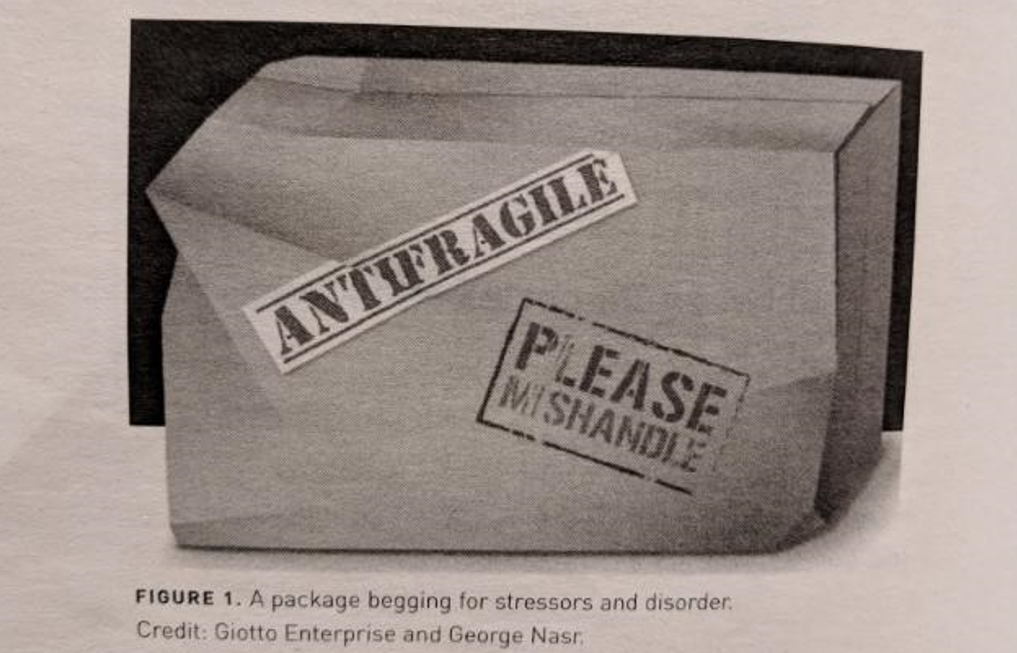Fragile entities are destroyed or damaged when they are exposed to disorder or stressed beyond a certain point. Think of purchasing a set of glasses that are at high risk to be shattered during the delivery process. For example, by a bump on the road. Appling stress to a fragile object leads quickly to a loss in value.

Robust entities are things that withstand high amounts of stress under which fragile objects would have shattered easily. Such things might be bank saves which are able to withstand high amounts of stress to protect their contents. Some robust entities do not give in at all when exposed to stress, others are able to absorb high amounts of stress, but can return to their original status. Think of a rubber band, or the mythological phoenix creature that after its death, returns to its original form.
Now, Antifragile entities, according to the book “Antifragility” by Nicolas Taleb, are things that gain from disorder and stress. An example of this is the evolution of life. There is no end in sight, and it constantly adapts to changing circumstances to survive and evolve. In fragile, and at some point, even in robust systems, disorder increases. This introduces more and more chaos until, at some point, the system collapses. In the evolution of life, due to inheriting genes of the previously most adapted life forms, life manages not just to withstand chaos, but to introduce higher and higher life forms (Schrödinger, 1944/ 2012). Another mythological example would be the hydra. After one of its heads has been separated, two more will grow.

However, for a system to be antifragile, some parts of it must be fragile. This is necessary because the occasional collapse of sub-components provided crucial feedback for the overall antifragile system to learn what works well and what not. Think of, that any individual specimen of a species is usually fragile. If exposed to too much damage, it will die. However, the evolutionary system of life itself can take this feedback in the form of indicators of success and failure to adapt to future generations. Making the species antifragile (Taleb, 2012). A simpler example is physical exercise, in which you expose yourself to physical stress and adapt to e.g. increasing weights.

This serves as an introduction to the topic of antifragility. Now, what does this mean for businesses?
Some businesses try to avoid fragility with policies, governments try to avoid fragility with regulations. However, once efforts are made to remove any volatility to e.g., smooth out economic cycles, the vital stressors that enable things to adapt to ever-changing circumstances are removed. Resources become misallocated as the feedback loop that provided insights about what works and what does not, stops. This, ironically, makes the whole system extremely fragile. It only takes one unexpected shock to cause a chain reaction that quickly collapses the whole system. Tranquility leads to Fragility.
An example of an antifragile business entity would be an investment banker that benefits from “not having skin in the game” (Taleb, 2012). Modern bankers handle the money of others without being at risk themselves. If they do well, they collect bonuses. If they fail, they have not lost their own money. They have become antifragile.

A more positive example of antifragile businesses is the lean startup that learns from its mistakes to adapt itself to fulfill customer needs without wasting too many resources.

Eric Rise’s Build-Measure-Learn Loop from his book “The Lean Startup” (Ries, 2011)
But why does this matter? Why am I writing this blog post?
I was inspired by Sten Willemese’s Blog contribution (https://digitalstrategy.rsm.nl/2021/10/06/the-dark-pages-of-facebook/), where he explained the harmful effects that social media has on the younger generation. It was revealed that Facebook is aware of these issues, but decided to ignore them; “prioritizing its profits over the wellbeing of its users”.
Disorder, stress, chaos and damage in other systems are what make social media antifragile. Media such as Twitter or Facebook are thriving off other systems being fragile (Kenny, 2013).
Such other systems might be teens that are affected by conforming to unrealistic beauty standards suggested by social media, exposing them to unhealthy amounts of psychological stress. While harmful for the individual, social media gets flooded with posts from people that want to present their lives from their best sides. This is where social media has become antifragile. By causing stress to its users, the platform becomes antifragile as more and more users try to keep up with standards and set new trends.
This is just an assumption that I made. I hope this blog encourages you to see that the difference of fragile systems are not robust systems, but antifragile systems.
The concept of antifragility emphasizes the need for businesses to expose themselves to the unknown. It encourages prototyping and testing to produce and make every iteration of a product better to suits its user’s needs (Spring 2 Innovation, 2020). An approach for this could be design thinking, where organizations become antifragile by focusing on the user’s deepest pains and adjust their solutions accordingly. The fragile customers, with their pains and frustrations caused by stressors, can make a business antifragile if properly discovered, analyzed, interpreted, and implied.
Unfortunately, it is easier for a system to become antifragile at the expense of the fragility of its smaller sub-parts. This brings along inherent negative effects on entities lower in the chain.
I highly recommend checking out Talebs book, Antifragile (2012).
References:
https://www.campaignlive.co.uk/article/year-ahead-forsocial-media/1165874
Taleb, N. N. (2012). Antifragile: Things That Gain from Disorder. Random House.
Schrodinger/Penrose, E. (2012). What is Life?: With Mind and Matter and Autobiographical Sketches (Canto Classics) (Reprint ed.). Cambridge University Press.
Ries, E. (2011). The Lean Startup: How Today’s Entrepreneurs Use Continuous Innovation to Create Radically Successful Businesses (Illustrated ed.). Currency.
(I do not own any of the pictures in this post)



